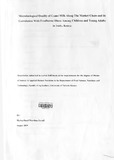| dc.description.abstract | The study was done to determine the microbiological quality of raw camel milk along the
informal market chain and to assess risk factors in symptoms of food-borne illnesses and the
role of camel milk in the diet of camel pastoralists. Camel milk samples were collected from
the milking point, camel milk first collection point (primary collectors) in the local market
center and at the final market in Nairobi. Microbiological assessment involved enumeration
of total bacterial count (TBC), presumptive Streptococcal/ Enterococcal count (PSEC), Yeast
and Mold count (YMC), Enterobacteriaceae count (ESe), and presumptive Staphylococcal
count (PSC). Determination of the shelf life of pasteurized camel milk stored at 4-7°C, 25°C,
and at 30°C was also investigated. Raw camel milk was pasteurized at 65°C for 30 minutes in
a water bath. Further, a cross sectional study was carried out by interviewing 993 randomly
selected households in peri-urban zone of Isiolo town to assess risk factors in symptoms of
food-borne illnesses with special attention given to the consumption of camel milk, cow milk
and goat milk.
Results indicate that microbial counts were increasing along the marketing chain. Camels'
milk milked in aseptic manner from the udder had TBC 2.lxI01-4.7xI04 cfurnl', PSEC
2.lxI01-IAxI03 cfuml', YMC I.lx101-I02 cfuml", EBC I.lxI01-S.lxI02 cfuml' and PSC
I.SxIOI-2AxI04 cfuml'. Bulked milk at the herd level had TBC 9.2xI02_1.7xI04 cfuml",
PSEC 3.7xI01-3AxI02 cfuml', YMC 2.lxI01-2.7xI02 cfuml', EBC I.lxI01-S.lxI02 cfumrl
and PSC 3.SxI02-S.3xI03 cfumrl• Bulked camel milk at the primary collector at the local
market center had TBC I.lxI03-S.6xI05 cfuml", PSEC 3.lxI01_2.7xI04 cfuml", YMC
I.lxIOI-S.OxIO<1 cfurnl', EBe 101_3.0xI05 cfuml", PSC 6.0xI02-S.2xI04 cfumr' while
bulked milk at the final market in Nairobi had TBC 4.7xI05-107 cfurnl', PSEC 2.0xI02-
5.4x104 cfurnl", YMC 9.SxI02x3.2xI03cfumrl
, EBC IAxI04-3.SxI06 cfumrl and PSC
9.lxI04_2.SxI05 cfumrl.Milk at the milking level had TBCs not exceeding microbiological
limit of 105 cfumrl and thus a grade I quality milk. At primary collectors 25% had EBC
exceeding 103 cfumrl indicating grade II quality of milk. 75% of bulked milk at the final
market exceeded the TBC acceptable limits of 106 cfumrl and EBC of 5.0x 104 cfumrl which
is in grade III and IV quality of raw milk which per the Kenya bureau of Standards 2006,
indicates poor quality milk and a threat to human health.
The Kenya Bureau of Standards specifications for pasteurized cow milk were applied as
criteria to establish the shelf life of camel milk. The shelf life was considered ended when the
Total bacteria counts exceeded 3.0x 104 cfuml', Enterobacteriaceae count was> 10 cfumrl
or alcohol test positive. Raw milk used had Total Bacteria Count 5.7x105 cfurnl',
Enterobacteriaceae Count l.4x 104 cfurn l I, Presumptive Streptococcal/ Enterococcal Count
1.2xl04 cfuml', Presumptive Staphylococcal Count 6.7x103 cfuml', Yeast and mold Count
9.5x I01 cfurnl', acidity 0.16%, pH 6.64, antibiotic residue tree, hydrogen peroxide free and
alcohol test negative. The residue TBC after pasteurization process was less than 10 cfumrl
while EBC, PSEC, PSC and YMC were completely destroyed. TBC of pasteurized camel
milk stored at 4-7°C exceeded the KEBS specifications in 49-54 days while TBCs of camel
milk stored at 25DC and at 30DC exceeded the limit in less than 24 hours. Thus with
appropriate refrigeration, pasteurized camel mi Ik keeps for longer periods than when exposed
to high ambient temperatures.
Results of the cross-sectional survey indicate raw camel milk as highly significant to foodborne
illnesses. Raw camel milk had odds ratio (OR) 2.1; 95% confidence interval (CI) 1.38-
3.22, and p-value of 0.001 for cases with diarrhoea and/or vomiting either with or without
fever. Raw camel milk was also found to have OR 3.4; 95% CI= 1.52-7.80; p= 0.003 for
cases with diarrhoea and/or vomiting without fever and was not significant for cases with
vomiting without fever (OR 2.9; 95% Cl 0.91- 8.97; p=0.071). Backward selection
multivariate logistic regression indicates raw camel milk as a risk factor to food-borne
poisoning with OR 2.6; 95% Cl=I.61-4.31, p=O.OOO; Log likelihood value (P (LRX2)) =
0.0002; raw cow milk emerged as a protective factor with OR 0.5; 95% Cl=0.33-0.89,
p=0.015, P (LRX2) = 0.0145. Washing of hands with soap, treating drinking water, boiling of
milk, presence of proper drainage system and improved pit latrine emerged as significant
protective factors to symptoms of food-borne poisoning. Since unhygienically handled raw
camel milk was associated with food-borne illnesses, consumers of camel milk should be
sensitized either to boil or consume processed camel milk. This study recommends for urgent
development and adaptation of feasible and sustainable interventions to improve the camel
milk hygiene and safety in Kenya and to mitigate food-borne related diseases in the agropastoralist
regions. | en |

